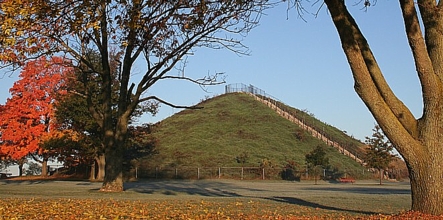Mound builders
Mound Builder is a general term referring to certain cultures of pre-Columbian American Indians. These cultures built various styles of earthen mounds. There were burial, residential and ceremonial purposes. The cultures cover a long period of time. This is from about 3500 BCE to the 16th century CE. This includes the Archaic, Woodland and Mississippian periods. Notable cultures were the Adena, Hopewell, Plaquemine, Fort Ancient, Coles Creek and Mississippian cultures. These groups were around the Great Lakes, the Ohio River Valley, and the Mississippi River.

The mounds were flat structures with layers. They usually were pyramids. Some mounds were like domes.[1] Some mounds were effigy mounds. They had shapes of animals. One famous one is the Serpent Mound in Ohio.[2] The oldest mound is probably the Watson Brake in Louisiana.[3] Usually, elite made workers build the mounds. Some mounds were burial sites for elite people of the tribes.[1]
There were several records of these mounds. Hernando de Soto was one of the earliest to see and record these mounds. The French artist Jacques le Moyne made paintings of these mounds. All of the mounds today are from the Woodland and Mississippian periods.[1]
The mounds started to disappear with colonization. Disease decreased the population sizes of American Indians. Mound building ended after the 17th century.[1]
Related pages
changeReferences
change- ↑ 1.0 1.1 1.2 1.3 "The Mound Builders Essay -- National Register of Historic Places Indian Mounds of Mississippi Travel Itinerary". www.nps.gov. Retrieved 2022-07-30.
- ↑ "Serpent Mound". Ohio History Connection. Retrieved 2022-07-29.
- ↑ Saunders, in Rees and Brown (2010), Archaeology of Louisiana, pp. 69–76